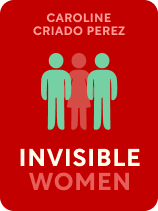

This article is an excerpt from the Shortform book guide to "Invisible Women" by Caroline Criado Perez. Shortform has the world's best summaries and analyses of books you should be reading.
Like this article? Sign up for a free trial here .
How does Invisible Women define data bias? How does data bias hurt women on a healthcare and safety level?
As explained in Invisible Women, data bias occurs when socio-cultural prejudices affect systematic processes. The author, Caroline Criado Perez, specifically talks about how a lack of information about the female experience affects women’s health, safety, and economic standing.
Continue reading to learn more about gender data bias.
Invisible Women‘s Data Bias Critique
When you read the words “average person,” who do you picture? If you’re like most people, you probably picture a man. In Invisible Women, feminist campaigner Caroline Criado Perez argues that this is because most humans operate under a male-as-default mindset: We consider the average person to be male. This mindset is particularly visible in gendered languages. For example, in Spanish, the masculine el doctor technically means “male doctor.” However, it is often used to refer to a doctor of any gender.
(Shortform note: Perez notes that gendered languages often default to the male forms of words, but some speakers of these languages are pushing back against these gendered words—which suggests that the male-as-default mindset may be waning. For example, some Spanish speakers use gender-neutral endings to words, like –e or –x.)
In Invisible Women, data bias is said to be caused by this male-as-default mindset. Perez contends that this also causes a lack of information about the female experience. This is because we don’t consider women the “average person,” so we don’t collect data on them.
(Shortform note: Although Perez didn’t coin the term “gender data gap,” data suggests that she did introduce it to the public consciousness. Google searches for “gender data gap” remained relatively low for years but spiked in February 2019. They have remained relatively high since then. Given that Invisible Women was published in March 2019, this spike appears to be related to the book’s popularity. The top related queries to the term also include both the author and the book’s name.)
In turn, this gender data gap reinforces the male-as-default mindset. When there is no data about women, people (especially men) assume that the experience of the average man represents the experience of the average woman. Given this, they continue to make choices that reflect this mindset. But ultimately it harms women. In this way, the male-as-default mindset and the gender data gap create a vicious, mutually reinforcing cycle.
How the Gender Data Gap Reinforces Itself
It’s not always the male-as-default mindset that causes or is reinforced by the gender data gap. Sometimes, one gender data gap sets off a self-reinforcing cycle or engenders another gender data gap. One of the world’s most popular websites, Wikipedia is ostensibly a gender-neutral encyclopedia. But further analysis demonstrates that it suffers from a gender data gap problem. Wikipedia is open source, meaning that anybody can edit it—but most of its editors are white American men.
Because these men don’t have firsthand information about the female experience, Wikipedia’s editing team suffers from a gender data gap. As a result, it makes decisions that discourage women from joining this team—like calling rape scenes in movies “sex scenes” because the term rape was “not neutral.” In this way, having mostly men on the editing team ensures that mostly men remain on the editing team—in other words, the gender data gap reinforces itself. And this lack of women on the editing team can be harmful to women’s health and safety. Several women on the editing team have been subject to harassment from other editors.
But that’s not all. Critics suggest that the lack of women on the editing team explains why Wikipedia’s data is skewed: Only 18% of the content on Wikipedia is about women, and articles about women are far more likely to be deleted despite meeting the company’s standards regarding whether they’re deserving of a Wikipedia entry. In this way, the gender data gap on the editing team engenders a gender data gap in which Wikipedia has insufficient information on women. And this may harm women’s economic standing, given that someone’s recognizability is often relevant to how much they’re paid, and having a Wikipedia page is an easy way to demonstrate that they’re a semi-public figure.

———End of Preview———
Like what you just read? Read the rest of the world's best book summary and analysis of Caroline Criado Perez's "Invisible Women" at Shortform .
Here's what you'll find in our full Invisible Women summary :
- How society's male-as-default mindset leads to a gender data gap
- Why cars don't properly protect women during accidents
- Why we don’t know how most medicines affect women






